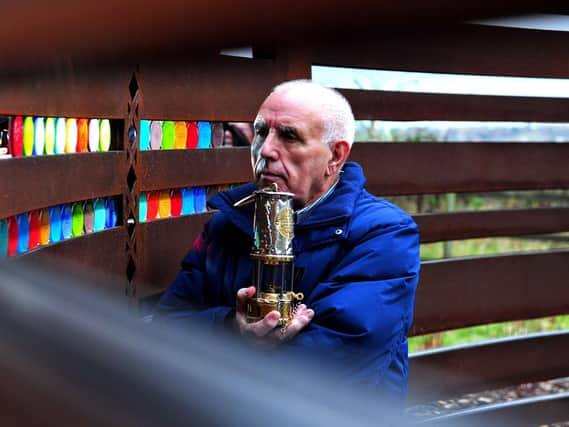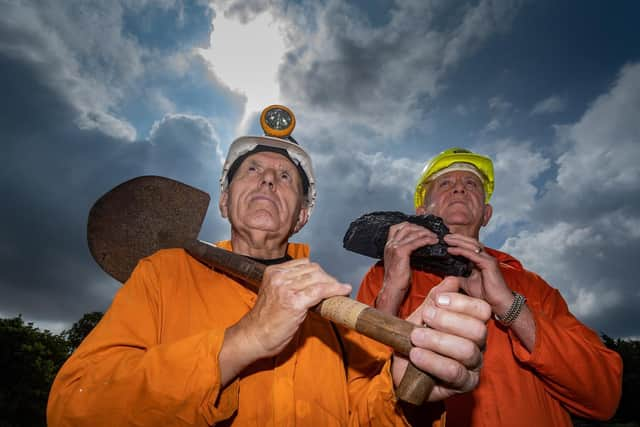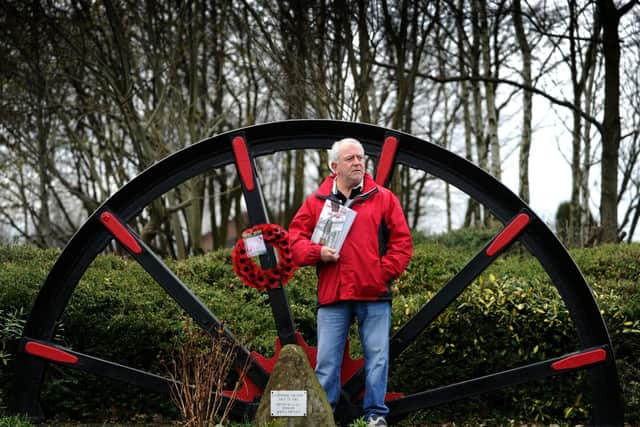Meet the former miners who work tirelessly to commemorate Yorkshire's coal heritage
This article contains affiliate links. We may earn a small commission on items purchased through this article, but that does not affect our editorial judgement.


“Mining made Yorkshire what it is,” says Eddie Downes with unwavering pride. “But when we have all gone, that heritage could die.”
In that short sentence, the 69-year-old sums up the motivation behind years of work to preserve and recognise the region’s coalfield history. Downes and a group of fellow former miners are behind a series of pit memorials to commemorate collieries across Yorkshire.
Advertisement
Hide AdAdvertisement
Hide AdThrough these, and by giving talks to schools and community groups about their own personal experiences, the men hope to keep the county’s mining heritage alive for years to come.


“We don’t do this for medals,” says Tony Banks, a fellow member of what he calls ‘the old miners’ group. “We do it to support our mining heritage.”
“I wouldn’t say our ambition is to put a memorial in every place,” Downes, of Lofthouse Gate, adds. “But we’ll put up as many as we can whilst we’re able.”
Between the pair and other members - Clive Cowell, Steve Wyatt, Keith Franks and Barry Downes, the group have been involved in memorials for sites including Oaks Colliery in Barnsley, Newmarket Silkstone Colliery in Wakefield and Allerton Bywater Colliery on the outskirts of Leeds.
Advertisement
Hide AdAdvertisement
Hide AdTheir current focus is having one installed in Lupset, Wakefield, to remember several of the area’s pits, as well as brickworks and engineering works. And they’re also working with Temple Newsam House on a pit wheel project to reflect the site’s mining heritage.


For Banks, the memorial at Lupset will hold a special significance as it marks the coal mine where he started his career, becoming the fifth generation of his family to work in mining. He was 15 when he joined Manor Colliery in 1957.
“All my family were in mining, both sides,” he recalls. “The Manor Pit was a real family pit. I’d got cousins working there. Some of my grandad’s relations were working there and I knew a lot of the lads anyway. It suited me.”
The pit top was where he started, but from 16, he was able to work underground. “I worked under Wakefield around the Cathedral pillar. You had to leave a pillar of coal under the Cathedral, so there’d be no subsidence.”
Advertisement
Hide AdAdvertisement
Hide AdBanks’ first role was pony driving. He would run tubs to men working at the coal face, returning them once they were filled. “We never stopped, apart from twenty minutes for us snap. But I really enjoyed it. It was the best job I had down the pit.”
When he was 18, Banks went to learn how to work on the coal face, becoming a collier at Manor, before later leaving to join Lofthouse Colliery in 1966. “It was a real eye opener. I’d been used to working at a pit that had 80 men.
"There were 1,000 men at Lofthouse on different shifts. They showed me the showers, the baths, I couldn’t believe it as there were two levels. At Manor, we only had about ten or 12 showers. At Lofthouse, it was massive.”
In 1971, Banks took promotion to a deputy role at the pit, supervising an area of the coalface and the men working on it. Advice given to him at the time by his father and grandfather has stayed with him. “They said there’s no problem with taking it but always remember to never ask a man to do anything that you wouldn’t do yourself and that’s stuck in my mind all my life.”
Advertisement
Hide AdAdvertisement
Hide AdTwo years later, Banks was standing in as overman, a role overseeing underground workings, when tragedy struck. In the early hours of March 21, 1973, an inrush of water trapped mineworkers below ground. Despite a six-day rescue effort, seven men died in the Lofthouse Colliery disaster, one of the worst mining catastrophes in British history.
“On March 20, I went to work and it was a night never to forget,” Banks recalls. “At about twenty past two in the morning, I’m on the coal face cutting away and there was such a rush of air and noise. I thought what was that? It knocked us off balance.”
Banks, who later went to work at Selby coalfield before a bad chest ended his career in the industry in 1995, has spent many years caring for a memorial in Wrenthorpe to those killed in the tragedy and is also chairman of the Lofthouse Disaster Trust Fund, set up in the aftermath to support the families of those who died.
“It was a sad time at Lofthouse,” he reflects. “The pit was never the same to me after that. Men never felt the same - I think the confidence had been knocked out of them all.”
Advertisement
Hide AdAdvertisement
Hide AdLofthouse Colliery has also been a focus of commemorative work for Downes, who first got involved with pit memorials in 2011. Part of a group of volunteers who help to maintain what is now Lofthouse Colliery Nature Park, Downes led on the creation of a heritage trail which opened at the site in 2013.
It features a pit memorial, interpretation panels and a downloadable app with recordings of former Lofthouse miners talking about what they did at the colliery. “It came on the back of a guided walk of the park with a group of former miners,” says Downes, who grew up in South Elmsall.
“They were asking where the shafts were. The cappings on the shafts are 120 feet below the surface so you can’t see them and miners like to see what’s left. They were really disappointed.”
Downes, who in 2016 published a comprehensive history of Yorkshire’s nationalised collieries, spent 23 years in mining after a chance meeting led to a job offer. Generations of his family had worked in the industry, but his dad had told him “in no uncertain terms” that he was not to go down the pit and instead Downes left grammar school wanting to be a field geologist.
Advertisement
Hide AdAdvertisement
Hide AdAfter tiring of studying, he took a job as a labourer at a local brickyard but was then offered a job at Frickley Colliery when he got chatting to a pit personnel manager in the pub one night. He accepted and went on to do a degree in mine engineering, later becoming involved in colliery management.
After leaving in 1983, Downes then worked for a number of companies who did jobs for mines across the world, specialising in tackling underground fires and filling voids - and he later formed his own firm. Like Banks, his personal and family connection with mining drives him keep the industry’s heritage alive.
Armed with mining memorabilia, ‘the old miners’ group have given talks to schoolchildren and community groups across the region and have also worked closely with the National Coal Mining Museum to support its events and exhibitions programme.
“The beauty about going to the schools is that the kids love it,” Downes says. “A lot of them haven’t a clue what a lump of coal is - they’re baffled. Yet most of them have got relatives who worked in the industry, a dad, a grandad, a great grandad. That’s why I do it.”
Advertisement
Hide AdAdvertisement
Hide Ad“I’m proud of what I did,” he adds. “[Miners] did a tremendous amount for this country, we kept it going for years and years.”
Banks is currently writing a book about his experiences in the mining industry, covering his early years right through to his memorial work post-retirement.
Reflecting on a visit by former Prime Minister Margaret Thatcher to the Selby coalfield, he says: “I’ll never forget what she said to the men that morning. She said you’re doing a fine job, you’ve got a job for life. This was 1980. There’s no coal mines left.”
Last year, Banks and Downes were involved with the Blot on the Landscape project at Temple Newsam, an exhibition exploring mining at the estate, which won a national award. They are among former miners now working with assistant community curator Helen Pratt on plans for a mining trail and pit wheel memorial at the site.
Advertisement
Hide AdAdvertisement
Hide AdFor more stories from the YP Magazine and The Yorkshire Post features team, visit our Facebook page.
Editor’s note: first and foremost - and rarely have I written down these words with more sincerity - I hope this finds you well.
Almost certainly you are here because you value the quality and the integrity of the journalism produced by The Yorkshire Post’s journalists - almost all of which live alongside you in Yorkshire, spending the wages they earn with Yorkshire businesses - who last year took this title to the industry watchdog’s Most Trusted Newspaper in Britain accolade.
And that is why I must make an urgent request of you: as advertising revenue declines, your support becomes evermore crucial to the maintenance of the journalistic standards expected of The Yorkshire Post. If you can, safely, please buy a paper or take up a subscription. We want to continue to make you proud of Yorkshire’s National Newspaper but we are going to need your help.
Advertisement
Hide AdAdvertisement
Hide AdPostal subscription copies can be ordered by calling 0330 4030066 or by emailing [email protected]. Vouchers, to be exchanged at retail sales outlets - our newsagents need you, too - can be subscribed to by contacting subscriptions on 0330 1235950 or by visiting www.localsubsplus.co.uk where you should select The Yorkshire Post from the list of titles available.
If you want to help right now, download our tablet app from the App / Play Stores. Every contribution you make helps to provide this county with the best regional journalism in the country.
Sincerely. Thank you.
James Mitchinson
Editor